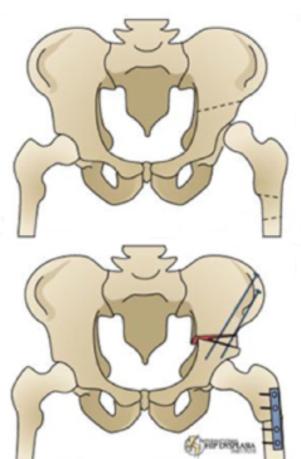Osteotomy refers to the surgical act of cutting a bone to change its shape, length or alignment. The orthopedic surgeons at Function use osteotomies to correct bones that are growing improperly in both typical children, and children with neuromuscular disorders such as cerebral palsy. Below are some example of osteotomies that are commonly performed in children with cerebral palsy to help keep them stay mobile and minimize the risk of pain and arthritis.
Hip Osteotomies: The hip joint is made up of the top of the femur bone (the “ball”) and the bottom of the pelvis bone (the “socket”). Sometimes the tight muscles seen in children with cerebral palsy cause the hip joint to dislocate. When this happens, the orthopedic surgeons at Function can cut the femur bone, the pelvis bone or both and bend them to put the hip joint back in place. After the bones are cut they are often fixed in place with metal screws and plates that can be removed later or stay in bone while it is healing. 
Foot osteotomies: CP can often result in deformities of the foot that may make it difficult to wear braces or shoes. These deformities can also cause pain to the child. The orthopedic surgeons at Function can cut one or more of the bones in the foot to re-align them and make the foot look more typical. Pins are usually used to hold the bones in place while they begin to heal. When used, these pins are removed in the office after a few weeks. The child wears a short leg cast for the first 6-12 weeks to further protect the bones.
Rotational Osteotomies: CP can also effect how the child’s feet point when they walk. When braces do not improve this abnormal rotation in the leg, the orthopedic surgeons at Function can cut the thigh bone or shin bones and rotate the bone to point the foot straighter. Again, the bones are fixed in a new position with metal plates and screws and usually a cast is worn afterwards.